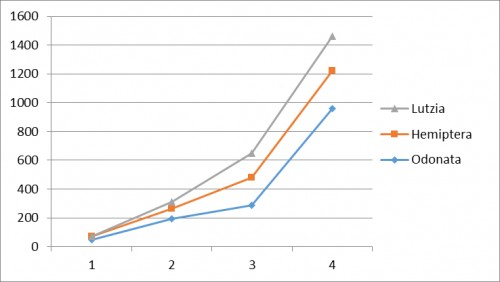Comparative studies of three potent bioagent against mosquito larvae
Author(s): Bhubaneshwari Devi Moirangthem, Salam Noren Singh and Dhananjoy Chingangbam Singh
Abstract: Mosquitoes are menace to human for centuries with their capability to spread dreaded diseases like malaria, dengue, filariasis etc. the control or managing them is the first priority of the humans ever since the cause of such diseases has been revealed. The usual ways to control include the spraying of insecticides or fumigation. Utilization of predacious insect larvae as well as the mosquito larvae are eco-friendly, sustainable and cost effective methods for the purposes. In the present study three insect larvae viz, Odonata (Sympatrum sp.), Hemiptera (Diplonychus sp.) and Diptera (Lutzia tigripes) were reared in the laboratory to check their efficacy on controlling the mosquito larvae efficiently. The larvae feeding them were the Culex species larvae. To find out the insect consuming larvae significantly more than others Turkey’s HSD for 3 means and 2 means are calculated and is found to be 61.19 and 48.79 respectively. Comparing the differences between the means, all means are found to be significantly different. The insect consuming larvae significantly than others is Odonata. In the same way, to find out the instar of the larvae at which insects consume them in significant amount Turkey’s HSD is calculated for 4, 3 and 2 means and they are 79.77, 70.66 and 56.34 respectively. Comparing the differences in the means with these values, it is found that insects consume larvae at 4th instar significantly more than the larvae at other stages. Out of the three larvae for managing or even controlling the mosquito larvae, Lutzia larvae might be the most efficient candidate for releasing in wild to control for they can survive and well adapted to the any habitats whether polluted or non-polluted but the Odonata and Hemiptera prefer somewhat non polluted aquatic habitats having moderate amount of dissolved oxygen. The main focus of the study is to select a bioagent that has no habitat boundary or constrain and nature of aquatic habitat. Hence the efficient candidate for controlling the mosquitoes of a particular habitat will be to utilize natures’ best weapon against the mosquitoes that is Lutzia tigripes.
 Fig.:
Fig.: The comparative efficiencies of three predacious insects and data were extracted from Table 1 (Data not shown).
How to cite this article:
Bhubaneshwari Devi Moirangthem, Salam Noren Singh, Dhananjoy Chingangbam Singh. Comparative studies of three potent bioagent against mosquito larvae. Int J Mosq Res 2018;5(6):10-14.



